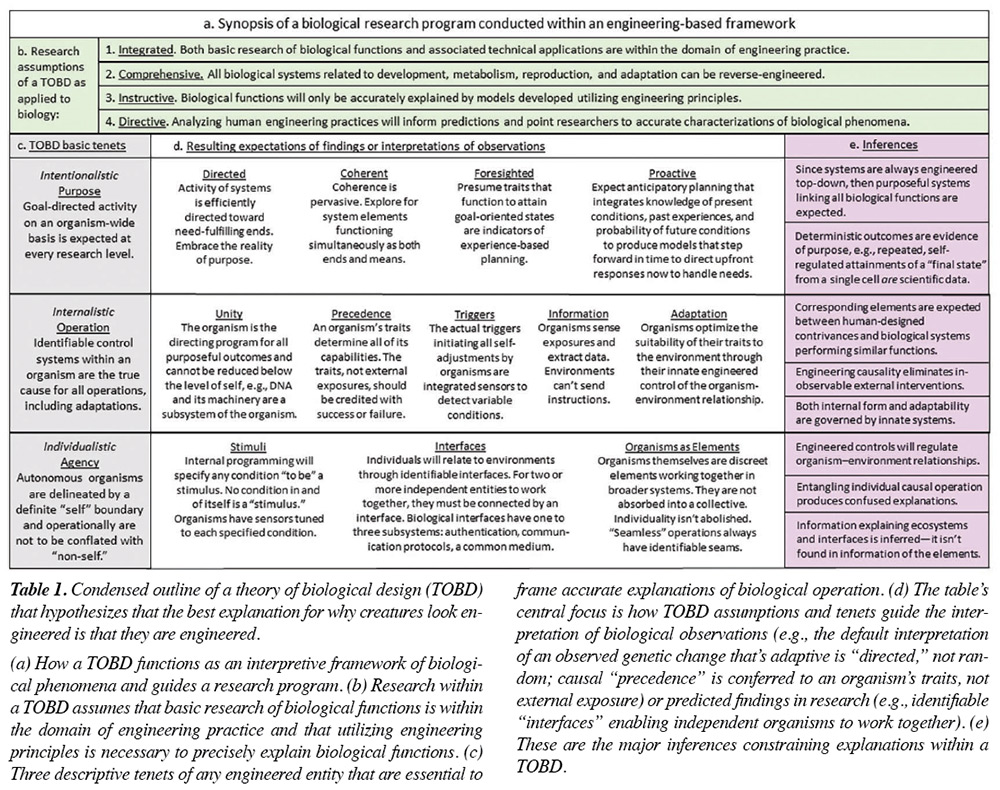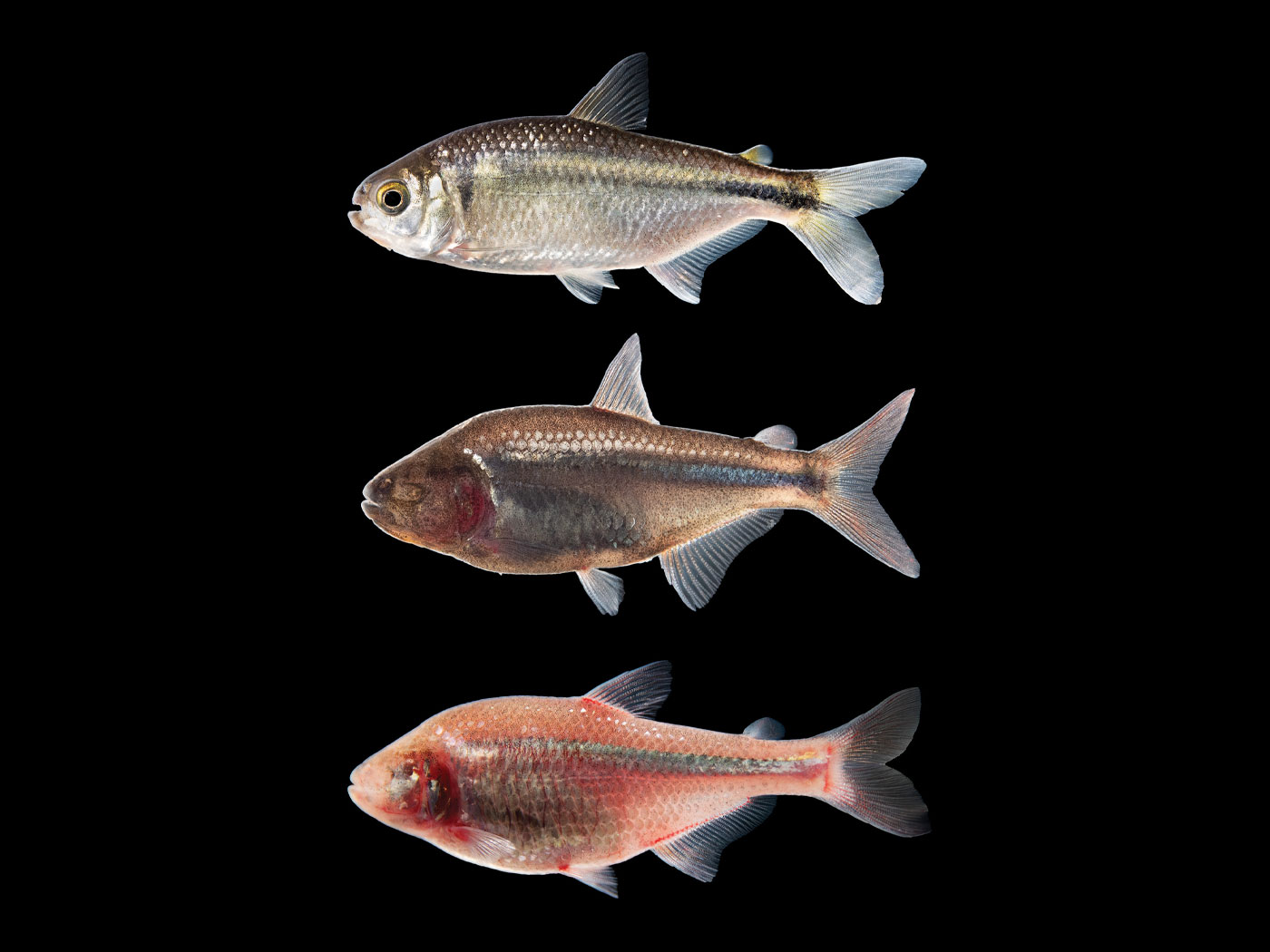Have you ever been reading a story when it dawns on you that the author merely took a biblical account and reset it to modern times with renamed characters? This isn’t uncommon, but at times biblical figures get recast with personalities that are the opposite of their true characters. In these twists, good becomes evil, and evil is good.
Charles Darwin was a master of exploiting the power of a familiar narrative while at the same time flipping the script. Before developing evolutionary theory, he was an astute student of both the design process and 19th-century theologian William Paley’s arguments for creatures being intelligently crafted by God. Darwin knew that the first step in supplanting a theory was to thoroughly understand it.
Likewise, creationists and intelligent design (ID) advocates need to thoroughly understand Darwinian selectionism as the central feature of Darwin’s theory—and particularly how it decisively “inverts the explanation” of origins.1
Darwin’s Strategy: Maintain Paley’s Observations (the Framework) but Invert the Cause
The exquisite engineering seen in biology has always been the big question that needs to be explained. Darwin could have tackled it in several ways. One tactic would be to simply deny any design by claiming that creatures really show overwhelmingly shoddy workmanship, engineering mistakes, or accumulated “junk.”
Some evolutionists have taken up this kludge of thinking when reacting to ID advocates. Yet, Darwin rejected this “argument from ignorance.” He knew that many people would intuitively conclude that such talk is foolish. Besides, it would most certainly be overturned by future research.
Darwin would have none of that and took a cleverer approach that readily acknowledged features of design. First, he rolled into his narrative familiar perceptions about the operation of engineered entities. Thus, his narrative requires more discernment to understand its true implications. It’s mentally difficult to disentangle his causation from all others—even design-based ones.
Second, Darwin fully granted that organisms do show exceptional characteristics that are indicative of highly intelligent engineering. But instead of attributing biological design to the agency of a (1) supernatural, (2) conscious, and (3) loving (4) God, Darwin’s narrative flips everything around and tells of a (-1) totally natural, (-2) unconscious, and (-3) cruel process that (-4) enables nature to exercise godlike agency. Stephen Jay Gould gives this insightful history:
[Darwin] holds that this order, the very basis of Paley’s inference about the nature of God, arises…as a side-consequence of a causal principle [natural selection] of entirely opposite import….Could any argument be more subversive? One accepts the conventional observation, but then offers an explanation that not only inverts orthodoxy, but seems to mock the standard interpretation….This more radical version lies at the core of Darwin’s argument for natural selection.2
A New Theory Is Needed, Not Just Positive Evidence for Biological Design
Darwin’s narrative makes it very hard to reject it—in ways that design advocates seem to miss. Consider how his story affects typical positive arguments for design. When promoters of design build an impressive list of complicated anatomical and physiological features, in effect Darwinians say, “Bring it on.”
Even when biology displays telltale characteristics of an intelligent agent, selectionists respond, “Our unconscious—yet creative—process mirrors intelligent agency.” So, when design advocates also project agency to “selection” by saying, “All selection can do is…” or “Selection can only act on…,” they reinforce the selectionist’s assertion that selection mimics the characteristics of intelligent agents.
That’s because another Darwinian causal inversion treats nature as the creative agent—not as the product of a creative agent. Darwinists project onto nature the same selective characteristics as a human agent (i.e., intelligence and volition). They simultaneously hold that there’s no purpose in the grand scheme, especially for random mutations.
Their story gets away with inserting messy purposelessness because nature’s agency is up to the task of “sorting” through organisms’ randomly appearing traits3—albeit through an arbitrary trial-and-error process—and it inevitably sees, selects, saves, and builds from the best. In this way, blind “Mother Nature” creatively cobbles together creatures3 and slowly refines their traits to look like a brilliant engineer made them. “Thus, according to Darwin, nature itself constitutes the supreme animal breeder that shapes the path of life.”4
Amassing positive evidence for biological design can’t jettison evolutionary theory. Darwin’s narrative absorbs a seemingly endless tally of features in organisms that definitively characterize engineering or agency (e.g., specified complexity, irreducible complexity, optimization, etc.).
Per the scientific method, documenting the abundant scientific weaknesses of evolution should’ve sufficed for rejection, even without a replacement theory.5 But that isn’t reality. Even counterintuitive theories that can barely tread water scientifically will continue to do so…until an alternative theory arises. Listing engineered features that clearly infer design doesn’t constitute a theory because it doesn’t do the work of a real theory—setting a research agenda, making predictions, and framing interpretations of observations.
What’s needed is a new engineering-based theory of biological design (TOBD), a synopsis of which is given in Table 1. Across the top are foundational assumptions, and on the left underneath are its tenets. The table’s main focus is the white section. This details significant research predictions or guides how observations are interpreted by those assumptions and tenets. These all reverse the major transpositions of thinking introduced by selectionism.
Readers should view Table 1 as a way to launch new thinking—akin to taping a preliminary chart to a wall in a planning meeting—where additional input from engaged readers and others will modify it over time.
TOBD Assumptions Set the Course for Real and Accurate Explanations
Darwin’s counterintuitive narrative relies on enormous helpings of imagination, illegitimate analogies, and exaggerated metaphors to sound believable. We saw in the part 2 article that the narrative props themselves became key assumptions in evolutionary theory.6 These assumptions lead to explanations that amount to “just so” stories, “Mother Nature…free floating intentions…phantom breeders [and] ghosts in Darwinism”7 that produce “the kinds of speculative flights associated with Darwinian theory.”8
The result? Careful biological research gets framed within a fanciful narrative gloss that transports those explanations away from reality and straight into mystical realms.
The assumptions of a TOBD, accordingly, are fundamentally anti-mystical. They counter the anti-design thrust of selectionism by reversing causality in cause-effect associations. This provides an initial trajectory for biological explanations that enhances their likelihood of being realistic and accurate. TOBD hypothesizes that the best explanation for why creatures look engineered is that they are engineered. Therefore, two major tenets guide its prediction of findings and interpretation of observations:
1. Basic research of biological functions and technical applications are both within the domain of engineering practice.
2. Biological functions can only be accurately explained by models developed utilizing engineering principles since these are essential to make correct cause-effect associations.
For clarity, these assumptions refer to the tangible, specific biological functions of reproduction, growth, metabolism, and adaptation. All living things manifest these in various ways. Engineered biology doesn’t deal with other characteristics of many living things like consciousness or “life” itself.
There are objective reasons to see biology as a discipline of engineering. Engineering principles are increasingly recognized in and applied to biology. At its core, basic biological research is reverse engineering, and currently this can be done with all known biological systems. Consistent with engineered biology, no biological function has yet eluded an actual or conceptual explanation by engineering principles, and the known consistency is broad between human engineered systems and biological systems.Just like man-made things, biomolecular, physiological, and anatomical functions operate within natural laws. The correspondence between human engineering and biology has aided inventions such as aircraft designs based on studying birds. Yet, the benefit of a TOBD to biology goes the other direction: it shows that analyzing human engineering practices can inform predictions and point researchers to accurate characterizations of biological phenomena.
TOBD’s Top Priority: Undo Darwin’s Inversion of Causes and Assumptions
In building a TOBD, the strategic importance of reversing Darwin’s cause-effect inversions must be understood at the outset. If they aren’t restored to their pre-Darwin engineering-based understanding, then the TOBD will be off track from the outset and cannot effectively counter selectionism.

1. Reverse “Life Emerges from Biological Operations” to “Life Is What Enables Ongoing Biological Operations”
In contrast to engineered biology, evolutionists have faith in a bevy of counterintuitive beliefs like nonliving chemicals giving rise to living cells, purposeless interactions producing purposeful systems, and non-agency making organisms with agency. Similarly, most of them hold that life and consciousness (including our thoughts) are somehow generated strictly by biological operations.
Yet what’s fundamentally different about creatures compared to even fully functional bio-systems or human-engineered things can’t be explained by either engineered biology or selectionism. That difference is “life.”
Life itself seems distinct from the material things we’re familiar with. No one has held a beaker of life, developed a sensor that detects life within creatures, or identified how it emerges from biological operations. We only observe when something has life. Some biological operations even persist after life departs until fuel in the cells is exhausted.
Thus far, life hasn’t been explained—or generated by—biological operations or engineering principles. Likewise, there are no definitive studies identifying how consciousness or agency arise from the actions of neurons. These are objective and important observations indicating that life, like consciousness, seems immaterial. If so, then life must be imparted to creatures from a source of life. The Bible says that source is God.
How this reversion influences research and interpretations: Recognize that efforts to explain life solely in terms of chemistry, physics, or even engineering principles are likely misguided. Evolutionary biology is constrained to explain life materially, but engineered biology intentionally makes no attempt to explain life. Instead, a TOBD focuses on explaining tangible biological functions with engineering principles.
2. Reverse “Nature is Like a Human Breeder Who Favors Selected Entities” to “Engineering Causality Eliminates Mystical Steps in Causal Explanations”
Darwin’s narrative not only interprets observations with inverted causes but also relies heavily on the illegitimate analogy likening unconscious nature with intelligent and volitional human breeders.9 Through this spurious comparison, he infused into evolutionary biology three anti-scientific practices—circular thinking, imagination, and personification of nature—that continuously breed mystical biological agents.10 Richard Dawkins’ theory of “selfish genes”is a wholesale magical explanation inspired by Darwin’s personification of nature.11
Imaginary causes are essentially nonexistent in engineering literature. Engineering causality is distinguished by clarity, objectivity, and thoroughness. Engineers only include verifiable elements—and don’t omit vital elements—in causal chains. Thus, biology benefits greatly from the precision that a TOBD brings to explaining the cause of an observation.
How this reversion influences research and interpretations: Engineered causality rejects inserting into causal explanations any unobserved “selection events,” nonquantifiable “selection pressures,” and nonidentifiable “objects/units of selection” as misleading thinking due to their inherent mysticism. On the other hand, it searches for all system elements involved in organisms’ detection of environmental exposures and their conditioned self-adjustments.
Engineering causation focuses on whole systems—not exclusively on individual elements. When key system elements are all needed for a result, then no single element is declared to be causal (e.g., genes aren’t “the cause” of traits).
3. Reverse “Pointless, Random Genetic Mutations” to “Purposeful, Goal-Oriented Actions Indicative of Top- Down Planning”
My part 2 series article explained why randomness figures so heavily in the anti-design objective of selectionism.6 It’s the counterview to purposeful actions. Even at a 2016 meeting convened to debate revisions to evolutionary theory, evolutionists circled the wagons against innate, purposeful biological activity. Perry Marshall spells this out.
[Attendees were] towing the standard Neo-Darwinian line, which insists that in the end, all comes down to “selection, selection, selection.”…But in the Neo-Darwinian view, for any cell to evolve purposefully is unthinkable. So of course “natural selection” always ends up being the answer.12
A tenet of a TOBD is that it’s intentionalistic. Goal-directed activity on an organism-wide basis is expected at every research level. When purposeful biological activity is observed, there’s no pressure to concoct stories to explain purpose away.
How this reversion influences research and interpretations: When an epigenetic/genetic change is identified related to a trait that’s observed to solve an environmental challenge, the default interpretation will be that these changes are purposeful/directed and not random unless evidence confirms randomness.
This is where a TOBD shines in guiding research. In contrast to the fundamental evolutionary assumption that selection is purposeless with respect to future needs of organisms, engineered biology predicts discovering valuable biological systems and suggests what elements to search for.
For example, a TOBD expects to find biological anticipatory systems in some organisms that produce innate models that step forward in time to handle predicted future needs by directing upfront responses now. TOBD-guided research suggests experiments to test for anticipatory controls and information that integrate knowledge of present conditions, past experiences, and probabilities of future conditions.
4. Reverse “Passive Organisms Shaped by Active External Conditions” to “Active Organisms Engineered with the Innate Capacity to Shape Themselves”
When environments change, it seems organisms often change in purposeful ways to fit that change. How does that happen? In a view called externalism, Darwin and his followers believe that the environment “drives” these changes as passive organisms are molded by “selective pressure.” Gould notes that Darwin understood the importance of an externalistic theory far better than others, saying,
Darwin’s theory, in strong and revolutionary contrast, presents a first “externalist” account of evolution…Darwin overturned all previous traditions by thus granting the external environment a causal and controlling role in the direction of evolutionary change.13
Engineering analysis shows that externalism is nonsense. Why? Because the function of any engineered entity must be explained in terms of its internal capability. Some claim externalism versus internalism is a logical false dichotomy, but these are two diametrically opposing views. The best way to understand internalism is to meticulously run through the mental exercise of designing an entity that adapts to its environment. You’ll see that all the capability the entity will ever have must be designed into it upfront—even any ability to learn from experiences.
A tenet of a TOBD is that it’s internalistic. Identifiable control systems within organisms are the true cause for all operations, including adaptations. Engineered solutions to problems must precede the problem; they aren’t “due to” the problem. In populations, varieties of traits in individuals represent potential engineered solutions to problems that may succeed; problems don’t “select” their solutions.
How this reversion influences research and interpretations: Suppose an aircraft flying on autopilot and terrain-following radar approaches and then automatically flies over a mountain. Externalists claim the mountain played an obvious causal role. Internalists say the aircraft caused its own change in altitude, and the mountain is a variable that’s either present or not. As the aircraft circles around for a second pass over the mountain, its terrain-following radar is turned off. Mountains don’t cause aircraft to climb. Similarly, a TOBD interprets all biological causality on the basis of trait capability—not external exposures.
5. Reverse “Mystical Forces Controlling Interrelated Biological Operations” to “Organisms are Discreet, Operative Elements of Whole Ecosystems”
An engineering-based approach is essential in attempts to track an ecosystem’s many moving parts. Selectionism currently jumbles materialism, externalism, and personifications of nature into an utterly confused story. A TOBD clarifies causality by teasing apart this tangle.
Organisms respond to numerous exposures in ecosystems, and sometimes these relationships are so close they’re termed “seamless.” Since evolutionists shun an engineered approach, they’re confounded as to what’s causing what.
For instance, some operations between bacteria and humans are so interdependent and exquisitely tuned to each other that many researchers see a single human–microbe amalgam or “supra-organism.” Or we’ll read something like, “Flowers evolved a clever strategy for controlling bees by sending them signals.” Are these explanations true? No, they entangle individual causal operation, which produces mystical explanations.
Causal explanations are further muddled within selectionism by another bungle that’s hard to spot. We detect within bee-flower relationships a higher level of information that isn’t found in either organism alone. How they relate together is only inferred by an outside observer of their mutual fit. This corresponds to a human-engineered communication system in which the information involved in the system as a whole is at a higher level than the information underlying the individual transmitter and receiver.
Selectionism is constructed to reject the existence of such higher information. But myriads of purposeful ecological relationships need explaining—and agent-causation is hard to duck. Again, personification of nature is an external pseudo-agent that’s inserted in technical literature with explanations like “the environment directly instructs the organism how to vary” or “the environment is giving instructive information as well as selective pressures.”14 Other evolutionary biologists don’t catch these mystical insertions, even though no sensor exists to detect some external “inducer” of organisms or environments sending instructions.15
A tenet of a TOBD is that it’s individualistic. Organisms are autonomous entities delineated by a definite “self” boundary. Innate, engineered control systems regulate organism-environment relationships. The TOBD explanation that organisms are discreet, operative, purposefully arranged elements of ecosystems contrasts with unverifiable stories like “coevolution,” appeals to extreme serendipity, or the idea that creatures are absorbed into the collective offered by evolutionists.
How this reversion influences research and interpretations: TOBD interpretations flow from the engineering principle that for two or more independent entities to work together, they must be connected by an interface. Engineers expend considerable work designing ways for complex things to work together through the identifiable elements of interfaces. So, researchers would develop more useful explanations of ecosystems with experiments designed to characterize how those essential elements are uniquely expressed between interrelated creatures.
Engineering principles demonstrate that no external condition in and of itself is a “stimulus,” “cue,” “inducer,” etc., but rather internal programing within entities must specify conditions to be a stimulus.
Conclusion
If we’re open to the possibility that our training has conditioned us to interpret biological observations in the opposite way from an engineering-based framework, then we’ll be able to appreciate biology in a fundamentally different way. Make no mistake, Darwin’s theory heads toward a nontheistic goal, but his idea to concede design—but invert the cause—avoids making an overtly offensive attack directly against God’s existence. Darwin simply lets people conclude that God isn’t needed.

Click here to read “Why Biology Needs A Theory of Biological Design, Part 1.”
Click here to read “Why Biology Needs A Theory of Biological Design, Part 2.”
Click here to read “Why Biology Needs A Theory of Biological Design, Part 4.”
References
- Gould, S. J. 2002. The Structure of Evolutionary Theory. Cambridge, MA: Harvard University Press, 119. Stephen Jay Gould notes that after rereading William Paley’s 1802 book Natural Theology, he found Darwin’s words and discourse in The Origin closely matched Paley’s, saying, “I was struck by the correspondences between Paley’s and Darwin’s structure of argument (though Darwin, of course, inverts the explanation).”
- Ibid, 120–121. Emphasis added.
- Ayala, F. J. 2007. Darwin’s greatest discovery: Design without designer. Proceedings of the National Academy of Sciences. 104: 8567–8573.
- Dembski, W. A. 2004. The Design Revolution: Answering the Toughest Questions about Intelligent Design. Downers Grove, IL: InterVarsity Press, 80.
- Guliuzza, R. J. 2024. Why Biology Needs a Theory of Biological Design, Part 1. Acts & Facts. 53 (2): 4–7.
- Guliuzza, R. J. 2024. Why Biology Needs a Theory of Biological Design, Part 2. Acts & Facts. 53 (3): 4–7.
- Fodor, J. and M. Piattelli-Palmarini. 2010. What Darwin Got Wrong. New York, NY: Farrar, Straus and Giroux, 162–163.
- Thomas, N. 2021. Taking Leave of Darwin: A Longtime Agnostic Discovers the Case for Design. Seattle, WA: Discovery Institute Press, 124.
- “The classical Darwinist account of evolution as primarily driven by natural selection is in trouble on both conceptual and empirical grounds. Darwin was too much an environmentalist. He seems to have been seduced by an analogy to selective breeding, with natural selection operating in place of the breeder. But this analogy is patently flawed; selective breeding is performed only by creatures with minds, and natural selection doesn’t have one of those. The alternative possibility to Darwin’s is that the direction of phenotypic change is very largely determined by endogenous variables.” Fodor, J. 2010. Why Pigs Don’t have Wings. London Review of Books. 29 (20): 19–22.
- Guliuzza, R. J. 2023. How Darwin Poisons Science. Acts & Facts. 52 (5): 4–7.
- Dawkins, R. 1976. The Selfish Gene. New York, NY: Oxford University Press, preface. For a critique, see Midgley, M. 2011. The selfish metaphor: Conceits of evolution. New Scientist. 2797 (19): 26–27.
- Marshall, P. Royal Society’s “New Trends in Biological Evolution” – A Bloodless Revolution. Evolution2. Posted on evo2.org November 30, 2016, accessed May 29, 2024. Emphasis added.
- Gould, The Structure of Evolutionary Theory, 160–161. See also Guliuzza, R. J. 2017. Engineered Adaptability: Adaptability via Nature or Design? What Evolutionists Say. Acts & Facts. 46 (9): 17–19; Guliuzza, R. J. 2019. Engineered Adaptability: Engineered Features Determine Design Success or Failure. Acts & Facts. 48 (6): 17–19.
- Kirschner, M. and J. Gerhart. 2005. The Plausibility of Life: Resolving Darwin’s Dilemma. New Haven, CT: Yale University Press, 31; Gilbert, S. F. and D. Epel. 2009. Ecological Developmental Biology: Integrating Epigenetics, Medicine, and Evolution. Sunderland, MA: Sinauer Associates, 407.
- “In everyday parlance, environmental stimuli is said to induce or even regulate the expression of specific genes. This notion is so engraved in the biological conceptual system that it comes as a revelation when, upon closer scrutiny, it turns out that no external stimuli that could directly induce the expression of any gene are known. No biotic or abiotic agent per se (the viruses’ case is irrelevant) is capable of inducing expression of any gene.” Cabej, N. R. 2013. Building the Most Complex Structure on Earth: An Epigenetic Narrative of Development and Evolution of Animals (Elsevier Insights). New York, NY: Elsevier Publishing. 199.
* Dr. Guliuzza is president of the Institute for Creation Research. He earned his doctor of medicine from the University of Minnesota, his master of public health from Harvard University, and received an honorary doctor of divinity from Southern California Seminary. He served in the U.S. Air Force as 28th Bomb Wing flight surgeon and chief of aerospace medicine. Dr. Guliuzza is also a registered professional engineer and holds a B.A. in theology from Moody Bible Institute.




















